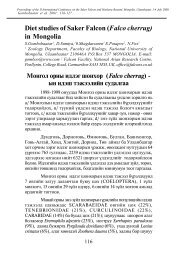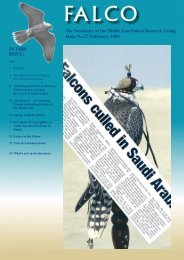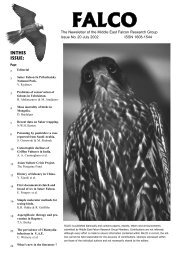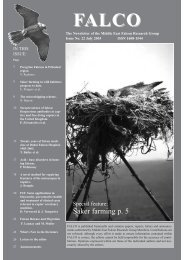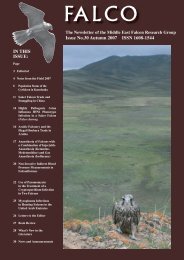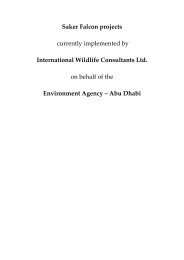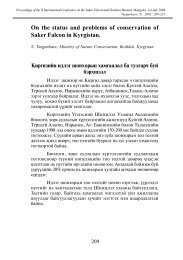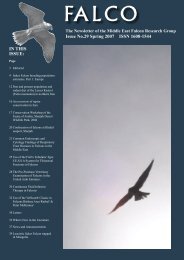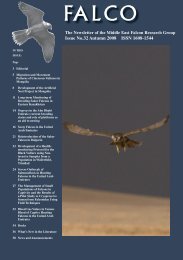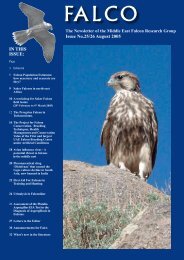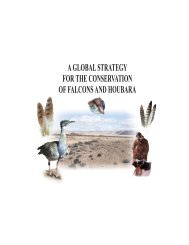Falco cherrug - International Wildlife Consultants Ltd.
Falco cherrug - International Wildlife Consultants Ltd.
Falco cherrug - International Wildlife Consultants Ltd.
You also want an ePaper? Increase the reach of your titles
YUMPU automatically turns print PDFs into web optimized ePapers that Google loves.
Year<br />
Number of<br />
nests<br />
Substrates<br />
Cliff Tree Electric<br />
line<br />
Nest provider<br />
Imperial Kite,<br />
Eagle Buzzard<br />
Other Flat<br />
ground<br />
Buteo<br />
lagopus,<br />
B. rufinus<br />
Raven Golden<br />
Eagle<br />
Others Not<br />
identified<br />
Scrape<br />
Altay-Sayan<br />
1999 88 88 81 4 1 1 1<br />
2000 72 66 6 42 20 1 2 4 2 1<br />
2001 51 38 13 35 10 1 1 1 3<br />
2002 52 39 3 7 2 1 38 7 1 3 3<br />
2003 23 21 1 1 16 5 1 1<br />
1999- 286 252 10 21 2 1 212 46 4 2 7 7 6 2<br />
2003<br />
Western Sibeira<br />
2000-<br />
2003 38 1 37 1 1 32 2 2<br />
Southern Urals<br />
1994-<br />
2003 12 8 4 6 6<br />
Eastern Volga and Western Urals<br />
1998-<br />
2000 4 3 1 1 1 1<br />
Total for Russia<br />
1994-<br />
2003 340 261 54 22 2 1 218 54 5 35 10 9 6 2<br />
Table 3. Substrates of Saker nests in Russia and the original builders of nests.<br />
Ural regions, however the Saker is almost non-existent here.<br />
This is rather mysterious. It is possible though, that these<br />
large Sousliks are not optimal quarry for the Sakers, and for<br />
optimal foraging the falcons need small and medium-size<br />
objects similar to Little Sousliks, Steppe Lemming and<br />
Brandt’s vole. It is worth noting that within the breeding territories<br />
of Sakers in Bashkiria and the Chelyabinsk District,<br />
which are located north of the ranges of the Little Sousliks,<br />
the habitat always has a large pasture and a pond, and in the<br />
diet (apart from Large Sousliks) Water Vole (Arvicola terrestris),<br />
ducks (Anas spp.), pigeons (Columba livia) and<br />
corvids (Corvus frugilegus, C. monedula) are well represented.<br />
Similar species composition was found in the diet of<br />
the Sakers in the Lower Kama (Ushakova 1968). Bogdanov<br />
(1871) was convinced that waterfowl are the main diet of<br />
Sakers in the Volga districts. Sakers that specialize on large<br />
birds and Water Voles have a naturally different foraging<br />
strategy from those that feed on small and medium size<br />
rodents, and passerines. This latter is not applicable in areas<br />
outside the range of small and medium size rodents, so the<br />
falcons have had to adapt themselves to consumption of<br />
non-traditional quarry, which, in turn, limits their recovery<br />
within the former range.<br />
In this paper the authors use authentic terminology<br />
which refers to the administration division of Russia. Here<br />
an explanation of the terms. District- in this paper means<br />
current ‘subject of federation’ (Oblast’), i.e. area large<br />
enough to have representation in the Russian Parliament.<br />
Before 1917 these units were called “Gubernia”. Kray –<br />
means a larger administrative division with more administrative<br />
powers. Kray and Districts have ‘regions’ “Rayon”<br />
which are smaller provinces within the ‘subjects of federation’.<br />
Before 1917 they were known as ‘uezd’. Nature<br />
Reserve in this paper means “Zapovednik” or strict Nature<br />
Reserve, i.e. a territory which is set aside for he purpose of<br />
Nature conservation and has limited access to general public.<br />
The Reference list for this paper you can find at the<br />
<strong>Falco</strong> electronic supplement together with the full text of the<br />
paper in Russian at our web site<br />
http://www.falcons.co.uk/mefrg/karyakin.htm<br />
Acknowledgments<br />
The authors thank all colleagues who participated<br />
in the collection of the data, and especially T. O.<br />
Barabashin, O.V. Bogdanova, I.V. Dyuzhaeva, D.A. Ilyina,<br />
M.A. Korolkov, A.V. Kotelnikov, A.E. Malygin, A.V.<br />
Mokhin, A.A. Orlenko, I.M. Pazhenkova, E. A. Pepelyaeva,<br />
A. V. Presnyakov, T. A. Trophimov, A. and A.A.<br />
Shestakova. We are grateful to B.S. Verichev, L.A., L.A.<br />
Edrenkina, V. M. Kuznetsov who helped us tremendously.<br />
M.A. Dubinina and A.Zh. Purekhovskiy for their help with<br />
GIS and the Forest Club of the Biodiversity Conservation<br />
Center, Moscow, for providing the maps, which were instrumental<br />
for maintaining the Saker nest database. The surveys<br />
were funded by the <strong>Falco</strong>n Research Insitute, NARC,<br />
ERWDA.<br />
9<br />
Editorial note



